Metal Additive Manufacturing (MAM) Applications in Production of Vehicle Parts and Components—A Review
Abstract
:1. Introduction
2. Materials and Methods
- methodology of the product formation,
- type of base material used,
- processing method.
- Material Jetting,
- Binder Jetting,
- Vat Photopolymerization,
- Powder Bed Fusion,
- Material Extrusion,
- Energy Deposition,
- Sheet Lamination.
- Solid-based (Laminated Object Manufacturing “LOM”, Fused Deposition Modelling “FDM”, Wire and Arc Additive Manufacturing “WAAM”, Electron Beam Free Form Fabrication “EBFFF”),
- Powder-based (Selective Laser Sintering “SLS” and Direct Metal Laser Sintering “DMLS”, Electron Beam Melting “EBM”, Selective Laser Melting “SLM”, Laser Metal Deposition “LMD”),
- Liquid-based (Stereolithography “SLS”, Direct Light Processing “DLP”, PolyJet printing).
- Laser beam,
- Ultraviolet rays,
- Thermal means.
3. Metal Additive Manufacturing
3.1. MAM Technologies
3.2. Examples of Vehicles Parts Produced via Metal Additive Manufacturing
3.2.1. Combustion Engines Components
3.2.2. Electric Motor Components
3.2.3. Drivetrain Components
3.2.4. Other Components
4. Discussion
5. Conclusions
- Additive techniques enable the production of components with intricate geometries that are often impossible to manufacture using other conventional techniques. This includes components with internal cellular structures designed in the CAD software like Solidworks, CATIA (Dassault Systemes, Vélizy, France).
- Additive techniques enable the creation of the manufacturing topology optimization model, for example with software like Fusion 360 (Autodesk, San Francisco, CA, USA). This results in significant material savings while maintaining appropriate mechanical properties.
- Additive manufacturing is associated with Industry 4.0 due to its ability to produce a component using a single machine, for example the EOS company (Krailling, Germany) or SLM Solutions Group AG (Lubeka, Germany). The direct operation of large and complex machines is avoided to ensure human safety.
- In the additive manufacturing process using powdered material, a small amount of waste is generated, in contrast to other manufacturing techniques like milling. Any unused powder can be reused in subsequent processes, provided it has been properly sieved and dried. This reduces the cost per element.
- Additive techniques enable the production of parts using a variety of metals and alloys, ranging from steel and its variants to aluminum, copper, and their alloys, as well as high-strength titanium alloys or Inconel.
- Typically, items produced through additive manufacturing exhibit a high strength-to-weight ratio. Thus, additive techniques are widely used in the mechanical industry to produce components such as pistons, crankshafts, valves, spur gears, camshafts, brake calipers, seat belts mount, movable roof mounts, etc.
- Additive techniques have been found to offer advantages over conventional methods for producing single-piece components with complex geometries.
Author Contributions
Funding
Institutional Review Board Statement
Informed Consent Statement
Data Availability Statement
Conflicts of Interest
References
- Silvestri, L.; Forcina, A.; Introna, V.; Santolamazza, A.; Cesarotti, V. Maintenance transformation through Industry 4.0 technologies: A systematic literature review. Comput. Ind. 2020, 123, 103335. [Google Scholar] [CrossRef]
- Shojaeinasab, A.; Charter, T.; Jalayer, M.; Khadivi, M.; Ogunfowora, O.; Raiyani, N.; Yaghoubi, M.; Najjaran, H. Intelligent manufacturing execution systems: A systematic review. J. Manuf. Syst. 2022, 62, 503–522. [Google Scholar] [CrossRef]
- Wang, B.; Tao, F.; Fang, X.; Liu, C.; Liu, Y.; Freiheit, T. Smart Manufacturing and Intelligent Manufacturing: A Comparative Review. Engineering 2021, 7, 738–757. [Google Scholar] [CrossRef]
- Dilberoglu, U.M.; Gharehpapagh, B.; Yaman, U.; Dolen, M. The Role of Additive Manufacturing in the Era of Industry 4.0. Procedia Manuf. 2017, 11, 545–554. [Google Scholar] [CrossRef]
- Sepasgozar, S.M.E.; Shi, A.; Yang, L.; Shirowzhan, S.; Edwards, D.J. Additive Manufacturing Applications for Industry 4.0: A Systematic Critical Review. Buildings 2020, 10, 231. [Google Scholar] [CrossRef]
- Hernandez Korner, M.E.; Lambán, M.P.; Albajez, J.A.; Santolaria, J.; Ng Corrales, L.D.C.; Royo, J. Systematic Literature Review: Integration of Additive Manufacturing and Industry 4.0. Metals 2020, 10, 1061. [Google Scholar] [CrossRef]
- Prashar, G.; Vasudev, H.; Bhuddhi, D. Additive manufacturing: Expanding 3D printing horizon in industry 4.0. Int. J. Interact. Des. Manuf. 2023, 17, 2221–2235. [Google Scholar] [CrossRef]
- ISO/ASTM 52900:2021; Additive Manufacturing—General Principles—Fundamentals and Vocabulary. ISO: Geneva, Switzerland, 2021. Available online: https://www.iso.org/obp/ui/#iso:std:iso-astm:52900:ed-2:v1:en (accessed on 21 January 2024).
- Quan, H.; Zhang, T.; Xu, H.; Luo, S.; Nie, J.; Zhu, X. Photo-curing 3D printing technique and its challenges. Bioact. Mater. 2020, 5, 110–115. [Google Scholar] [CrossRef]
- Wohlers Report 2023. Available online: https://wohlersassociates.com/product/wr2023/ (accessed on 6 January 2024).
- Stavropoulos, P.; Foteinopoulos, P.; Papacharalampopoulos, A.; Bikas, H. Addressing the challenges for the industrial application of additive manufacturing: Towards a hybrid solution. Int. J. Light. Mater. Manuf. 2018, 1, 157–168. [Google Scholar] [CrossRef]
- Javaid, M.; Haleem, A.; Singh, R.P.; Suman, R.; Rab, S. Role of additive manufacturing applications towards environmental sustainability. Adv. Ind. Eng. Polym. Res. 2021, 4, 312–322. [Google Scholar] [CrossRef]
- Pérez, M.; Carou, D.; Rubio, E.M.; Teti, R. Current advances in additive manufacturing. Procedia CIRP 2020, 88, 439–444. [Google Scholar] [CrossRef]
- Alghamdi, S.S.; John, S.; Choudhury, N.R.; Dutta, N.K. Additive Manufacturing of Polymer Materials: Progress, Promise and Challenges. Polymers 2021, 13, 753. [Google Scholar] [CrossRef]
- Nanjundarao, R.; Srinivasamurthy, S. Paradigm shift in Unmanned Aerial Vehicle (UAV) design—Design Freedom for multi-payload delivery systems, enabled by Additive Manufacturing. Researchgate, September 2018. Available online: https://www.researchgate.net/publication/327868762_Article_Paradigm_shift_in_Unmanned_Aerial_VehicleUAV_design-Design_Freedom_for_multi-payload_delivery_systems_enabled_by_Additive_Manufacturing (accessed on 2 December 2023).
- Li, J.; Wu, C.; Chu, P.K.; Gelinsky, M. 3D printing of hydrogels: Rational design strategies and emerging biomedical applications. Mater. Sci. Eng. R Rep. 2020, 140, 100543. [Google Scholar] [CrossRef]
- Lakhdar, Y.; Tuck, C.; Binner, J.; Terry, A.; Goodridge, R. Additive manufacturing of advanced ceramic materials. Prog. Mater. Sci. 2021, 116, 100736. [Google Scholar] [CrossRef]
- Black, H.T.; Celina, M.C.; Mcelhanon, J.R. SANDIA REPORT Additive Manufacturing of Polymers: Materials Opportunities and Emerging Applications. 2016. Available online: http://www.ntis.gov/search (accessed on 22 December 2023).
- Kristiawan, R.B.; Imaduddin, F.; Ariawan, D.; Ubaidillah; Arifin, Z. A review on the fused deposition modeling (FDM) 3D printing: Filament processing, materials, and printing parameters. Open Eng. 2021, 11, 639–649. [Google Scholar] [CrossRef]
- Dadkhah, M.; Tulliani, J.-M.; Saboori, A.; Iuliano, L. Additive manufacturing of ceramics: Advances, challenges, and outlook. J. Eur. Ceram. Soc. 2023, 43, 6635–6664. [Google Scholar] [CrossRef]
- Pelz, J.S.; Ku, N.; Meyers, M.A.; Vargas-Gonzalez, L.R. Additive manufacturing of structural ceramics: A historical perspective. J. Mater. Res. Technol. 2021, 15, 670–695. [Google Scholar] [CrossRef]
- Santoliquido, O.; Colombo, P.; Ortona, A. Additive Manufacturing of ceramic components by Digital Light Processing: A comparison between the “bottom-up” and the “top-down” approaches. J. Eur. Ceram. Soc. 2019, 39, 2140–2148. [Google Scholar] [CrossRef]
- Sun, J.; Ye, D.; Zou, J.; Chen, X.; Wang, Y.; Yuan, J.; Liang, H.; Qu, H.; Binner, J.; Bai, J. A review on additive manufacturing of ceramic matrix composites. J. Mater. Sci. Technol. 2023, 138, 1–16. [Google Scholar] [CrossRef]
- Katz-Demyanetz, A.; Popov, V.V.; Kovalevsky, A.; Safranchik, D.; Koptyug, A. Powder-bed additive manufacturing for aerospace application: Techniques, metallic and metal/ceramic composite materials and trends. Manuf. Rev. 2019, 6, 5. [Google Scholar] [CrossRef]
- Hu, Y.; Cong, W. A review on laser deposition-additive manufacturing of ceramics and ceramic reinforced metal matrix composites. Ceram. Int. 2018, 44, 20599–20612. [Google Scholar] [CrossRef]
- Yang, L.; Miyanaji, H. Ceramic Additive Manufacturing: A Review of Current Status and Challenges. In Proceedings of the 2017 International Solid Freeform Fabrication Symposium, Austin, TX, USA, 7–9 August 2017. [Google Scholar]
- Wang, B.; Zhao, Y.; Liu, G.; Thein, C.K.; Su, W.; Long, S.; Qi, H.; Wei, P.; He, Y.; Li, H.N. Preventing thermal osteonecrosis through 3D printed ceramic grinding tool. Addit. Manuf. 2023, 78, 103878. [Google Scholar] [CrossRef]
- Murr, L.E.; Martinez, E.; Amato, K.N.; Gaytan, S.M.; Hernandez, J.; Ramirez, D.A.; Wicker, R.B. Fabrication of Metal and Alloy Components by Additive Manufacturing: Examples of 3D Materials Science 43 Fabrication of Metal and Alloy Components by Additive Manufacturing: Examples of 3D Materials Science. J. Mater. Res. Technol. 2012, 1, 42–54. [Google Scholar] [CrossRef]
- Mukherjee, T.; Zuback, J.S.; De, A.; DebRoy, T. Printability of alloys for additive manufacturing. Sci. Rep. 2016, 6, 19717. [Google Scholar] [CrossRef]
- Sharma, A.; Bandari, V.; Ito, K.; Kohama, K.; Ramji, R.M.; Himasekhar, H.S. A new process for design and manufacture of tailor-made functionally graded composites through friction stir additive manufacturing. J. Manuf. Process. 2017, 26, 122–130. [Google Scholar] [CrossRef]
- Bagherifard, S.; Guagliano, M. Fatigue performance of cold spray deposits: Coating, repair and additive manufacturing cases. Int. J. Fatigue 2020, 139, 105744. [Google Scholar] [CrossRef]
- Bagherifard, S.; Astaraee, A.H.; Locati, M.; Nawaz, A.; Monti, S.; Kondás, J.; Singh, R.; Guagliano, M. Design and analysis of additive manufactured bimodal structures obtained by cold spray deposition. Addit. Manuf. 2020, 33, 101131. [Google Scholar] [CrossRef]
- Chen, W.; Thornley, L.; Coe, H.G.; Tonneslan, S.J.; Vericella, J.J.; Zhu, C.; Duoss, E.B.; Hunt, R.M.; Wight, M.J.; Apelian, D.; et al. Direct metal writing: Controlling the rheology through microstructure. Appl. Phys. Lett. 2017, 110, 014001. [Google Scholar] [CrossRef]
- Matthews, M.J.; Guss, G.; Drachenberg, D.R.; Demuth, J.A.; Heebner, J.E.; Duoss, E.B.; Kuntz, J.D.; Spadaccini, C.M. Diode-based additive manufacturing of metals using an optically-addressable light valve. Opt. Express 2017, 25, 11788–11800. [Google Scholar] [CrossRef]
- Tao, Y.; Yin, Q.; Li, P. An Additive Manufacturing Method Using Large-Scale Wood Inspired by Laminated Object Manufacturing and Plywood Technology. Polymers 2021, 13, 144. [Google Scholar] [CrossRef]
- Ahn, D.; Kweon, J.-H.; Choi, J.; Lee, S. Quantification of surface roughness of parts processed by laminated object manufacturing. J. Am. Acad. Dermatol. 2012, 212, 339–346. [Google Scholar] [CrossRef]
- Razavykia, A.; Brusa, E.; Delprete, C.; Yavari, R. An Overview of Additive Manufacturing Technologies—A Review to Technical Synthesis in Numerical Study of Selective Laser Melting. Materials 2020, 13, 3895. [Google Scholar] [CrossRef]
- Bhatt, P.M.; Kabir, A.M.; Peralta, M.; Bruck, H.A.; Gupta, S.K. A robotic cell for performing sheet lamination-based additive manufacturing. Addit. Manuf. 2019, 27, 278–289. [Google Scholar] [CrossRef]
- Vafadar, A.; Guzzomi, F.; Rassau, A.; Hayward, K. Advances in Metal Additive Manufacturing: A Review of Common Processes, Industrial Applications, and Current Challenges. Appl. Sci. 2021, 11, 1213. [Google Scholar] [CrossRef]
- Svetlizky, D.; Das, M.; Zheng, B.; Vyatskikh, A.L.; Bose, S.; Bandyopadhyay, A.; Schoenung, J.M.; Lavernia, E.J.; Eliaz, N. Directed energy deposition (DED) additive manufacturing: Physical characteristics, defects, challenges and applications. Mater. Today 2021, 49, 271–295. [Google Scholar] [CrossRef]
- Köhler, M.; Sun, L.; Hensel, J.; Pallaspuro, S.; Kömi, J.; Dilger, K.; Zhang, Z. Comparative study of deposition patterns for DED-Arc additive manufacturing of Al-4046. Mater. Des. 2021, 210, 110122. [Google Scholar] [CrossRef]
- Dass, A.; Moridi, A. State of the Art in Directed Energy Deposition: From Additive Manufacturing to Materials Design. Coatings 2019, 9, 418. [Google Scholar] [CrossRef]
- Blakey-Milner, B.; Gradl, P.; Snedden, G.; Brooks, M.; Pitot, J.; Lopez, E.; Leary, M.; Berto, F.; du Plessis, A. Metal additive manufacturing in aerospace: A review. Mater. Des. 2021, 209, 110008. [Google Scholar] [CrossRef]
- Saboori, A.; Aversa, A.; Marchese, G.; Biamino, S.; Lombardi, M.; Fino, P. Application of Directed Energy Deposition-Based Additive Manufacturing in Repair. Appl. Sci. 2019, 9, 3316. [Google Scholar] [CrossRef]
- Sinha, R.; Cámara-Torres, M.; Scopece, P.; Falzacappa, E.V.; Patelli, A.; Moroni, L.; Mota, C. A hybrid additive manufacturing platform to create bulk and surface composition gradients on scaffolds for tissue regeneration. Nat. Commun. 2021, 12, 500. [Google Scholar] [CrossRef]
- Yusuf, S.M.; Cutler, S.; Gao, N. Review: The Impact of Metal Additive Manufacturing on the Aerospace Industry. Metals 2019, 9, 1286. [Google Scholar] [CrossRef]
- Bechmann, F. Changing the future of additive manufacturing. Met. Powder Rep. 2014, 69, 37–40. [Google Scholar] [CrossRef]
- Ghasempour-Mouziraji, M.; Lagarinhos, J.; Afonso, D.; de Sousa, R.A. A review study on metal powder materials and processing parameters in Laser Metal Deposition. Opt. Laser Technol. 2024, 170, 110226. [Google Scholar] [CrossRef]
- Zhang, T.; Liu, C.-T. Design of titanium alloys by additive manufacturing: A critical review. Adv. Powder Mater. 2021, 1, 100014. [Google Scholar] [CrossRef]
- Ladani, L.; Sadeghilaridjani, M. Review of Powder Bed Fusion Additive Manufacturing for Metals. Metals 2021, 11, 1391. [Google Scholar] [CrossRef]
- Vock, S.; Klöden, B.; Kirchner, A.; Weißgärber, T.; Kieback, B. Powders for powder bed fusion: A review. Prog. Addit. Manuf. 2019, 4, 383–397. [Google Scholar] [CrossRef]
- Gordon, J.V.; Narra, S.P.; Cunningham, R.W.; Liu, H.; Chen, H.; Suter, R.M.; Beuth, J.L.; Rollett, A.D. Defect structure process maps for laser powder bed fusion additive manufacturing. Addit. Manuf. 2020, 36, 101552. [Google Scholar] [CrossRef]
- Yadroitsev, I.; Yadriotsava, I.; Plessis, A.D.; MacDonald, E. Fundamentals of Laser Powder Bed Fusion of Metals. In Additive Manufacturing and Technologies; Elsevier: Amsterdam, The Netherlands, 2021; Volume 1. [Google Scholar]
- Narasimharaju, S.R.; Zeng, W.; See, T.L.; Zhu, Z.; Scott, P.; Jiang, X.; Lou, S. A comprehensive review on laser powder bed fusion of steels: Processing, microstructure, defects and control methods, mechanical properties, current challenges and future trends. J. Manuf. Process. 2022, 75, 375–414. [Google Scholar] [CrossRef]
- Chowdhury, S.; Yadaiah, N.; Prakash, C.; Ramakrishna, S.; Dixit, S.; Gupta, L.R.; Buddhi, D. Laser powder bed fusion: A state-of-the-art review of the technology, materials, properties & defects, and numerical modelling. J. Mater. Res. Technol. 2022, 20, 2109–2172. [Google Scholar] [CrossRef]
- Ahn, D.-G. Directed Energy Deposition (DED) Process: State of the Art. Int. J. Precis. Eng. Manuf. Technol. 2021, 8, 703–742. [Google Scholar] [CrossRef]
- Frandsen, C.S.; Nielsen, M.M.; Chaudhuri, A.; Jayaram, J.; Govindan, K. In search for classification and selection of spare parts suitable for additive manufacturing: A literature review. Int. J. Prod. Res. 2020, 58, 970–996. [Google Scholar] [CrossRef]
- Knofius, N.; van der Heijden, M.; Zijm, W. Moving to additive manufacturing for spare parts supply. Comput. Ind. 2019, 113, 103134. [Google Scholar] [CrossRef]
- Tadjdeh, Y. 3D Printing Promises to Revolutionize Defense, Aerospace Industries. Natl. Defense 2014, 98, 20–23. [Google Scholar]
- Love, L.J.; Nycz, A.; Noakes, M.; Post, B.; Babu, A.R.S. Development and Demonstration of Large-Scale Metal Additive Manufacturing for Military Vehicle Applications-Final Report. 2016. Available online: http://www.osti.gov/scitech/ (accessed on 6 January 2024).
- Sarvankar, S.G.; Yewale, S.N. Additive Manufacturing in Automobile Industry. Int. J. Res. Aeronaut. Mech. Eng. 2019, 7, 1–10. [Google Scholar]
- Laureijs, R.E.; Roca, J.B.; Narra, S.P.; Montgomery, C.; Beuth, J.L.; Fuchs, E.R.H. Metal Additive Manufacturing: Cost Competitive Beyond Low Volumes. J. Manuf. Sci. Eng. 2017, 139, 081010. [Google Scholar] [CrossRef]
- Sarfraz, M.S.; Hong, H.; Kim, S.S. Recent developments in the manufacturing technologies of composite components and their cost-effectiveness in the automotive industry: A review study. Compos. Struct. 2021, 266, 113864. [Google Scholar] [CrossRef]
- Tyrer-Jones, A. Volkswagen Group Adds Second MetalFAB 3D Printer to Optimize Automotive Manufacturing. Available online: https://3dprintingindustry.com/news/volkswagen-group-adds-second-metalfab-3d-printer-to-optimize-automotive-manufacturing-222900/ (accessed on 6 January 2024).
- Shaikhnag, A. ARES Modena Customizes Supercars with Roboze’s ARGO 500 3D Printers. Available online: https://3dprintingindustry.com/news/ares-modena-customizes-supercars-with-robozes-argo-500-3d-printers-221181/ (accessed on 6 January 2024).
- Rupp, M.; Buck, M.; Klink, R.; Merkel, M.; Harrison, D.K. Additive manufacturing of steel for digital spare parts—A perspective on carbon emissions for decentral production. Clean. Environ. Syst. 2022, 4, 100069. [Google Scholar] [CrossRef]
- Heinen, J.J.; Hoberg, K. Assessing the potential of additive manufacturing for the provision of spare parts. J. Oper. Manag. 2019, 65, 810–826. [Google Scholar] [CrossRef]
- Tucker, R.; Khatamifar, M.; Lin, W.; McDonald, K. Experimental investigation of orientation and geometry effect on additive manufactured aluminium LED heat sinks under natural convection. Therm. Sci. Eng. Prog. 2021, 23, 100918. [Google Scholar] [CrossRef]
- McDonough, J. A perspective on the current and future roles of additive manufacturing in process engineering, with an emphasis on heat transfer. Therm. Sci. Eng. Prog. 2020, 19, 100594. [Google Scholar] [CrossRef]
- GFavero, G.; Bonesso, M.; Rebesan, P.; Dima, R.; Pepato, A.; Mancin, S. Additive manufacturing for thermal management applications: From experimental results to numerical modeling. Int. J. Thermofluids 2021, 10, 100091. [Google Scholar] [CrossRef]
- Mollamahmutoglu, M.; Yilmaz, O. Volumetric heat source model for laser-based powder bed fusion process in additive manufacturing. Therm. Sci. Eng. Prog. 2021, 25, 101021. [Google Scholar] [CrossRef]
- Ding, C.; Cui, X.; Jiao, J.; Zhu, P. Effects of Substrate Preheating Temperatures on the Microstructure, Properties, and Residual Stress of 12CrNi2 Prepared by Laser Cladding Deposition Technique. Materials 2018, 11, 2401. [Google Scholar] [CrossRef]
- Attaran, M. The rise of 3-D printing: The advantages of additive manufacturing over traditional manufacturing. Bus. Horiz. 2017, 60, 677–688. [Google Scholar] [CrossRef]
- Anusci, V. BMW’s New S58 Engine Features Cylinder Head Made with 3D Printing. Available online: https://www.voxelmatters.com/bmw-s58-engine-3d-printed-cylinder/ (accessed on 26 September 2023).
- JLi, J.; Duan, C.; Zhao, M.; Luo, X. A Review of Metal Additive Manufacturing Application and Numerical Simulation. IOP Conf. Ser. Earth Environ. Sci. 2019, 252, 022036. [Google Scholar] [CrossRef]
- Boissinneault, T. Honda Uses AM and Generative Design to Optimize Crankshaft. Available online: https://www.autodesk.com/customer-stories/honda-crankshaft-design (accessed on 6 January 2024).
- Dalpadulo, E.; Petruccioli, A.; Gherardini, F.; Leali, F. A Review of Automotive Spare-Part Reconstruction Based on Additive Manufacturing. J. Manuf. Mater. Process. 2022, 6, 133. [Google Scholar] [CrossRef]
- Bourell, D.L. Perspectives on Additive Manufacturing. Annu. Rev. Mater. Res. 2016, 46, 1–18. [Google Scholar] [CrossRef]
- Ickinger, F. 3D Printing Technology Optimises Pistons for the Powerful 911 GT2 RS. Available online: https://media.porsche.com/mediakit/porsche-innovationen/en/porsche-innovationen/3d-printed-pistons (accessed on 6 January 2024).
- Jia, D.; Li, F.; Zhang, Y. 3D-printing process design of lattice compressor impeller based on residual stress and deformation. Sci. Rep. 2020, 10, 600. [Google Scholar] [CrossRef] [PubMed]
- Yaghi, A.; Ayvar-Soberanis, S.; Moturu, S.; Bilkhu, R.; Afazov, S. Design against distortion for additive manufacturing. Addit. Manuf. 2019, 27, 224–235. [Google Scholar] [CrossRef]
- O’brien, J.; Montgomery, S.; Yaghi, A.; Afazov, S. Process chain simulation of laser powder bed fusion including heat treatment and surface hardening. CIRP J. Manuf. Sci. Technol. 2021, 32, 266–276. [Google Scholar] [CrossRef]
- I. Communications Ltd.; Williams, N.; Whittaker, P. Make the Future with Proven Powders Created by Praxair. 2021. Available online: www.metal-am.com (accessed on 5 December 2023).
- Gray, J.; Depcik, C.; Sietins, J.M.; Kudzal, A.; Rogers, R.; Cho, K. Production of the cylinder head and crankcase of a small internal combustion engine using metal laser powder bed fusion. J. Manuf. Process. 2023, 97, 100–114. [Google Scholar] [CrossRef]
- Chinthavali, M.; Ayers, C.; Campbell, S.; Wiles, R.; Ozpineci, B. A 10-kW SiC inverter with a novel printed metal power module with integrated cooling using additive manufacturing. In Proceedings of the 2014 IEEE Workshop on Wide Bandgap Power Devices and Applications, Knoxville, TN, USA, 13–15 October 2014. [Google Scholar]
- Selema, A.; Ibrahim, M.N.; Sergeant, P. Metal Additive Manufacturing for Electrical Machines: Technology Review and Latest Advancements. Energies 2022, 15, 1076. [Google Scholar] [CrossRef]
- Schuhmann, D.; Rockinger, C.; Merkel, M.; Harrison, D.K. A Study on Additive Manufacturing for Electromobility. World Electr. Veh. J. 2022, 13, 154. [Google Scholar] [CrossRef]
- Danninger, H. What Will Be the Future of Powder Metallurgy? Powder Met. Prog. 2018, 18, 70–79. [Google Scholar] [CrossRef]
- Pathak, S.; Böhm, M.; Kaufman, J.; Kopeček, J.; Zulić, S.; Stránský, O.; Shukla, A.; Brajer, J.; Beránek, L.; Radhakrisnan, J.; et al. Surface integrity of SLM manufactured meso-size gears in laser shock peening without coating. J. Manuf. Process. 2023, 85, 764–773. [Google Scholar] [CrossRef]
- Brummer, M.; Raddatz, K.J.; Schmitt, M.M.; Schlick, G.; Tobie, T.; Daub, R.; Stahl, K. Static load-carrying behavior and material properties of additively manufactured gears (PBF-LB/M, 16MnCr5). Rapid Prototyp. J. 2023, 29, 117–130. [Google Scholar] [CrossRef]
- Concli, F.; Bonaiti, L.; Gerosa, R.; Cortese, L.; Nalli, F.; Rosa, F.; Gorla, C. Bending Fatigue Behavior of 17-4 PH Gears Produced by Additive Manufacturing. Appl. Sci. 2021, 11, 3019. [Google Scholar] [CrossRef]
- Binder, M.; Stapff, V.; Heinig, A.; Schmitt, M.; Seidel, C.; Reinhart, G. Additive manufacturing of a passive, sensor-monitored 16MnCr5 steel gear incorporating a wireless signal transmission system. Procedia CIRP 2022, 107, 505–510. [Google Scholar] [CrossRef]
- Fan, F.; Soares, N.; Jalui, S.; Isaacson, A.; Savla, A.; Manogharan, G.; Simpson, T. Effects of Centrifugal Disc Finishing for Surface Improvements in Additively Manufactured Gears. In Proceedings of the 2021 International Solid Freeform Fabrication Symposium, Virtual, 2–4 August 2021. [Google Scholar]
- Zumofen, L. Function-and Weight-Optimized Gear Components by Laser Powder Bed Fusion (L-PBF). Available online: https://www.researchgate.net/publication/358557538 (accessed on 6 January 2024).
- Politis, D.J.; Politis, N.J.; Lin, J. Review of recent developments in manufacturing lightweight multi-metal gears. Prod. Eng. 2021, 15, 235–262. [Google Scholar] [CrossRef]
- Landi, D.; Zefinetti, F.C.; Spreafico, C.; Regazzoni, D. Comparative life cycle assessment of two different manufacturing technologies: Laser additive manufacturing and traditional technique. Procedia CIRP 2022, 105, 700–705. [Google Scholar] [CrossRef]
- Bräunig, J.; Töppel, T.; Müller, B.; Burkhardt, M.; Hipke, T.; Drossel, W.-G. Advanced Material Studies for Additive Manufacturing in terms of Future Gear Application. Adv. Mech. Eng. 2014, 6, 741083. [Google Scholar] [CrossRef]
- Dennig, H.-J.; Zumofen, L.; Stierli, D.; Kirchheim, A.; Winterberg, S. Increasing the safety against scuffing of additive manufactured gear wheels by internal cooling channels. Forsch. Im Ingenieurwesen/Eng. Res. 2022, 86, 595–604. [Google Scholar] [CrossRef]
- Patil, K. 3D Printed Titanium Brake Caliper in High-Performance Vehicles. In Proceedings of the Advanced Manufacturing Students Conference, Virtual, 21–25 June 2021; pp. 62–65. [Google Scholar]
- Tyflopoulos, E.; Lien, M.; Steinert, M. Optimization of Brake Calipers Using Topology Optimization for Additive Manufacturing. Appl. Sci. 2021, 11, 1437. [Google Scholar] [CrossRef]
- Alderton, M. Driving a Lighter, More Efficient Future of Automotive Part Design. Available online: https://www.autodesk.com/design-make/articles/automotive-design (accessed on 6 January 2024).
- Wang, Z.; Zhang, Y.; Bernard, A. A constructive solid geometry-based generative design method for additive manufacturing. Addit. Manuf. 2021, 41, 101952. [Google Scholar] [CrossRef]
- Watson, M.; Leary, M.; Downing, D.; Brandt, M. Generative design of space frames for additive manufacturing technology. Int. J. Adv. Manuf. Technol. 2023, 127, 4619–4639. [Google Scholar] [CrossRef]
- Wang, H.; Du, W.; Zhao, Y.; Wang, Y.; Hao, R.; Yang, M. Joints for treelike column structures based on generative design and additive manufacturing. J. Constr. Steel Res. 2021, 184, 106794. [Google Scholar] [CrossRef]
- Zhang, Y.; Wang, Z.; Zhang, Y.; Gomes, S.; Bernard, A. Bio-inspired generative design for support structure generation and optimization in Additive Manufacturing (AM). CIRP Ann. 2020, 69, 117–120. [Google Scholar] [CrossRef]
- Ladani, L.J. Applications of artificial intelligence and machine learning in metal additive manufacturing. J. Phys. Mater. 2021, 4, 042009. [Google Scholar] [CrossRef]
- Junk, S.; Burkart, L. Comparison of CAD systems for generative design for use with additive manufacturing. Procedia CIRP 2021, 100, 577–582. [Google Scholar] [CrossRef]
- Lunetto, V.; Catalano, A.R.; Priarone, P.C.; Salmi, A.; Atzeni, E.; Moos, S.; Iuliano, L.; Settineri, L. Additive manufacturing for an urban vehicle prototype: Re-design and sustainability implications. Procedia CIRP 2021, 99, 364–369. [Google Scholar] [CrossRef]
- TBriard, T.; Segonds, F.; Zamariola, N. G-DfAM: A methodological proposal of generative design for additive manufacturing in the automotive industry. Int. J. Interact. Des. Manuf. 2020, 14, 875–886. [Google Scholar] [CrossRef]
- Bassoli, E.; Defanti, S.; Tognoli, E.; Vincenzi, N.; Degli Esposti, L. Design for Additive Manufacturing and for Machining in the Automotive Field. Appl. Sci. 2021, 11, 7559. [Google Scholar] [CrossRef]
- Zhao, N.; Parthasarathy, M.; Patil, S.; Coates, D.; Myers, K.; Zhu, H.; Li, W. Direct additive manufacturing of metal parts for automotive applications. J. Manuf. Syst. 2023, 68, 368–375. [Google Scholar] [CrossRef]
- Putre, L. With a Small but Mighty Bracket, BMW Raises the Roof on 3-D Printing. echnology and IIOT. Available online: www.industryweek.com/technology-and-iiot/article/22026127/with-a-small-but-mighty-bracket-bmw-raises-the-roof-on-3-d-printing (accessed on 6 January 2024).
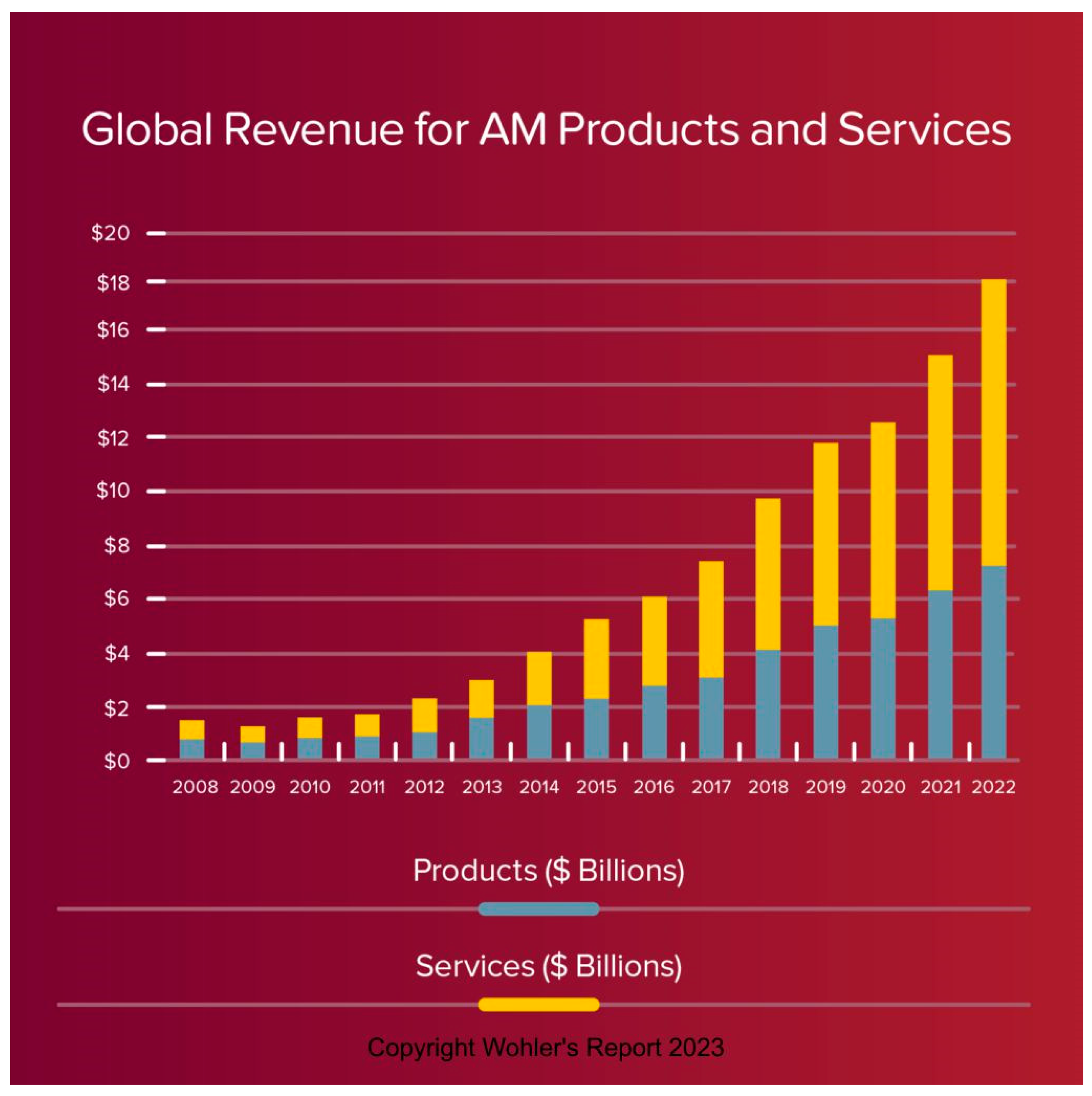
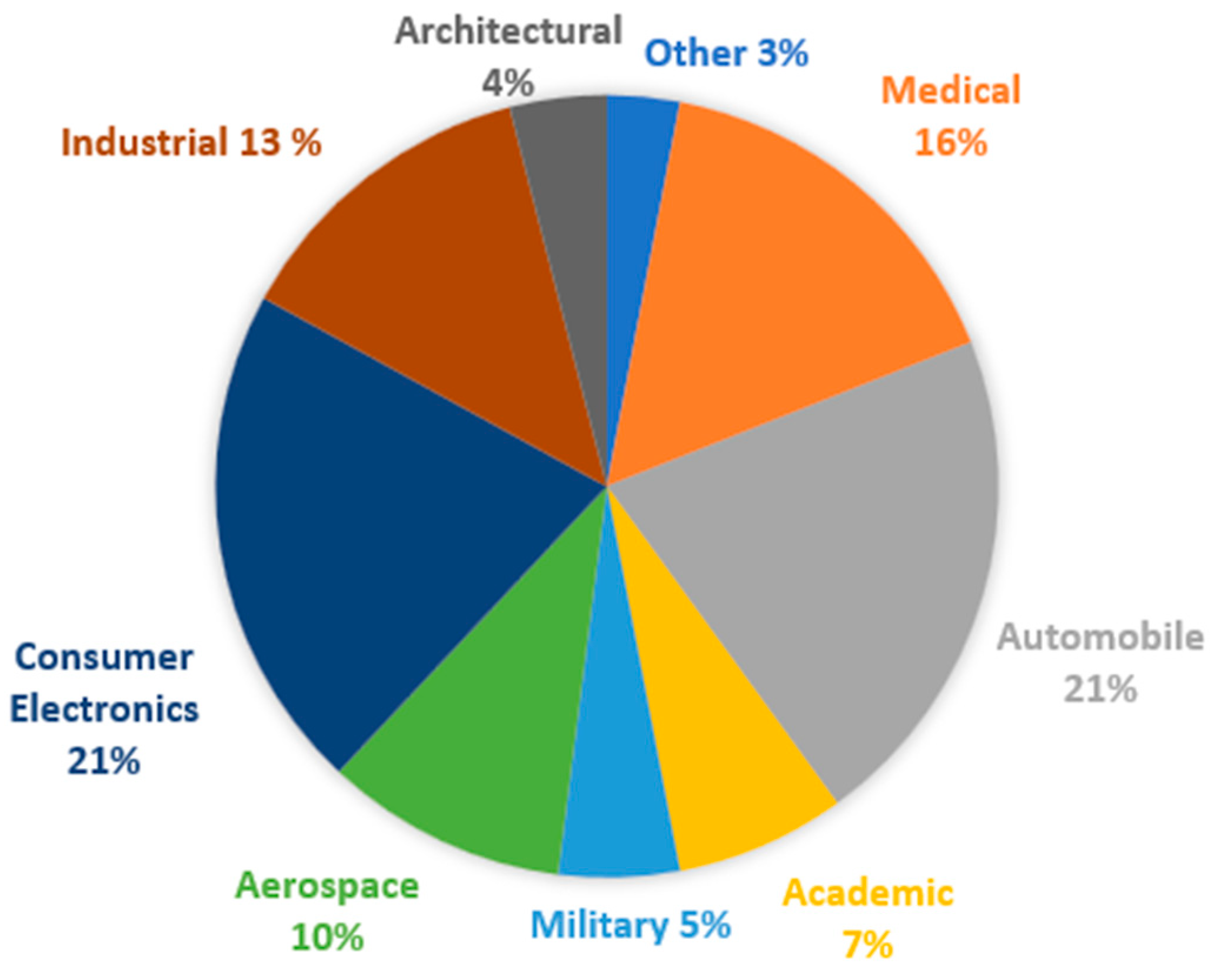

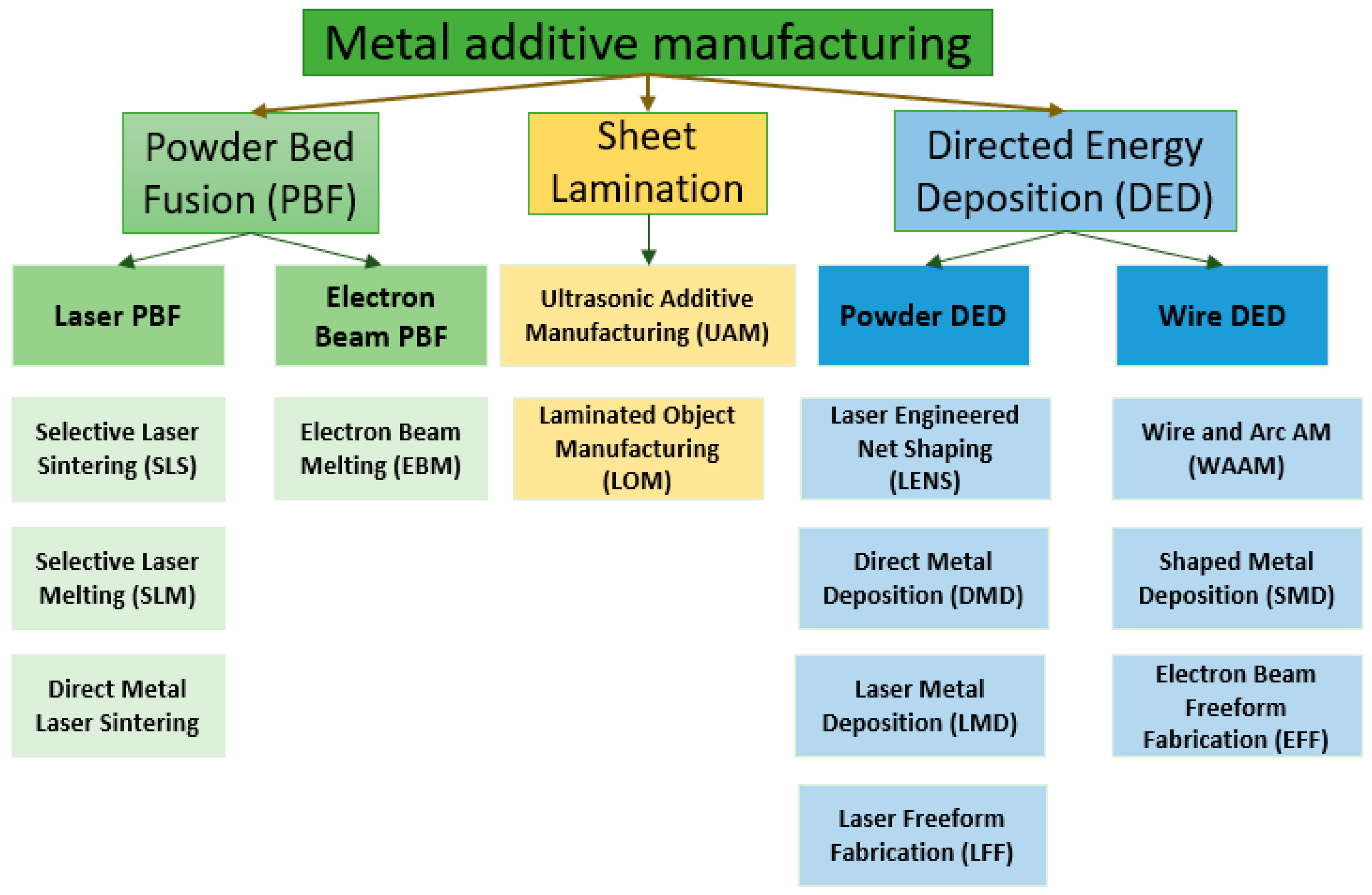
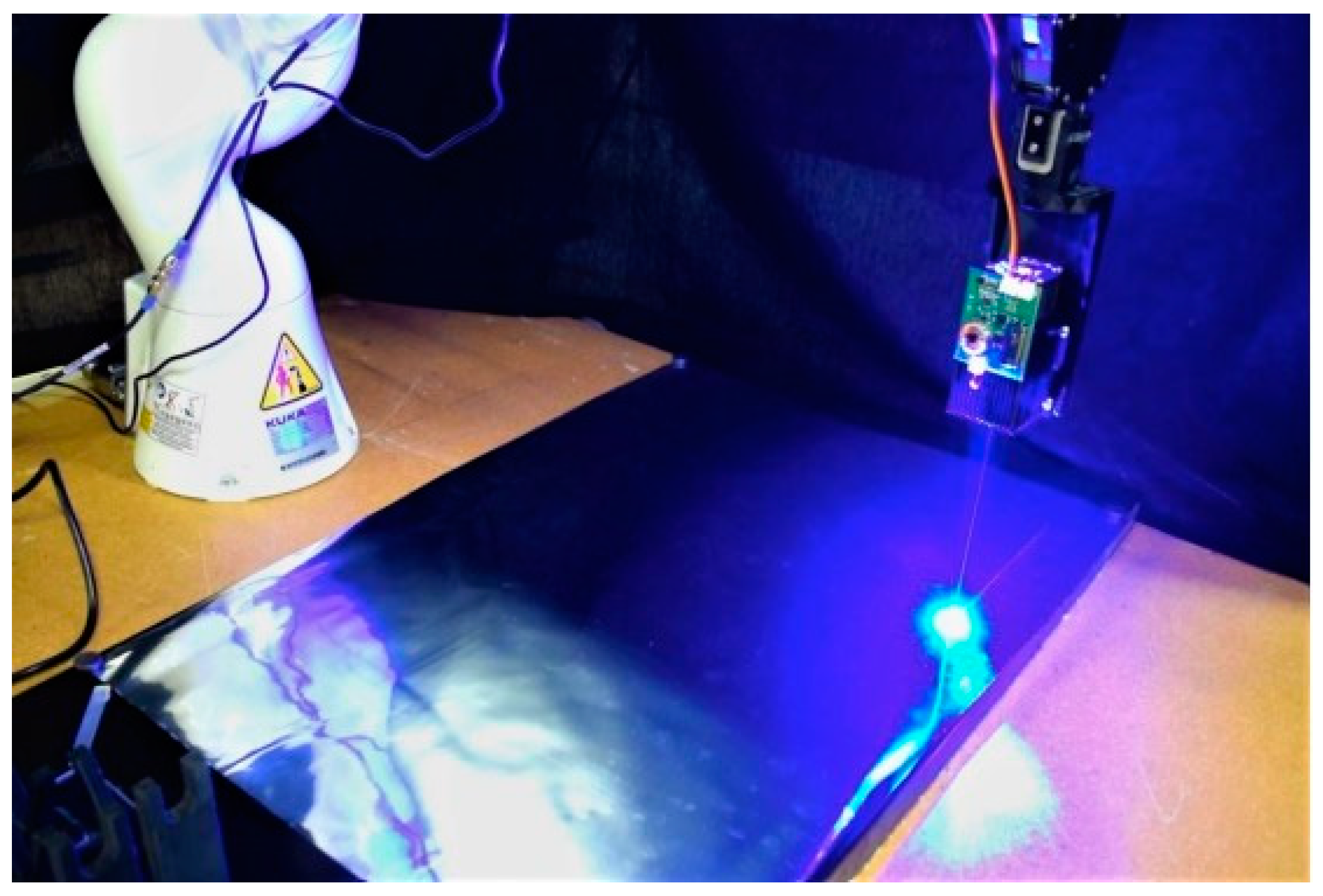
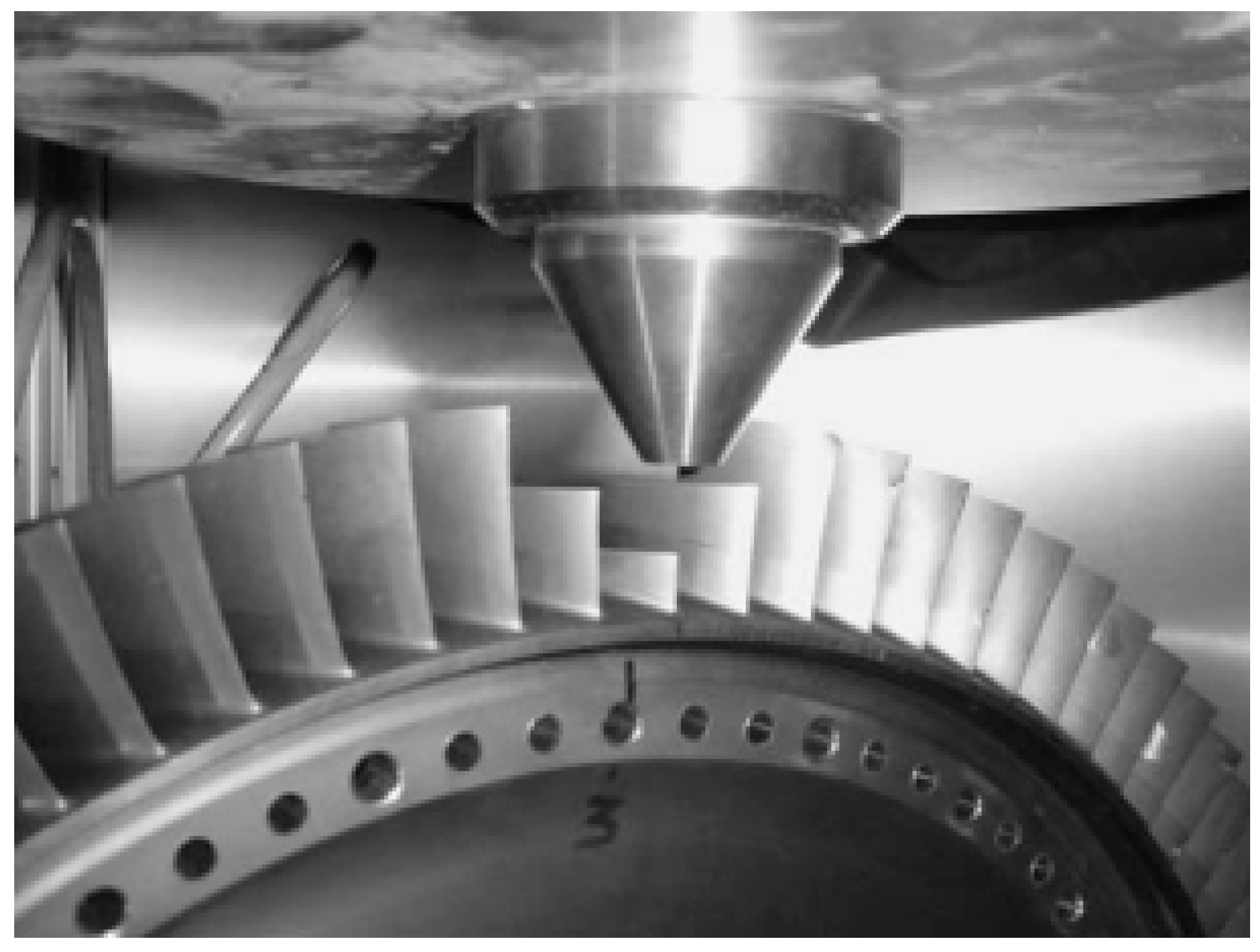


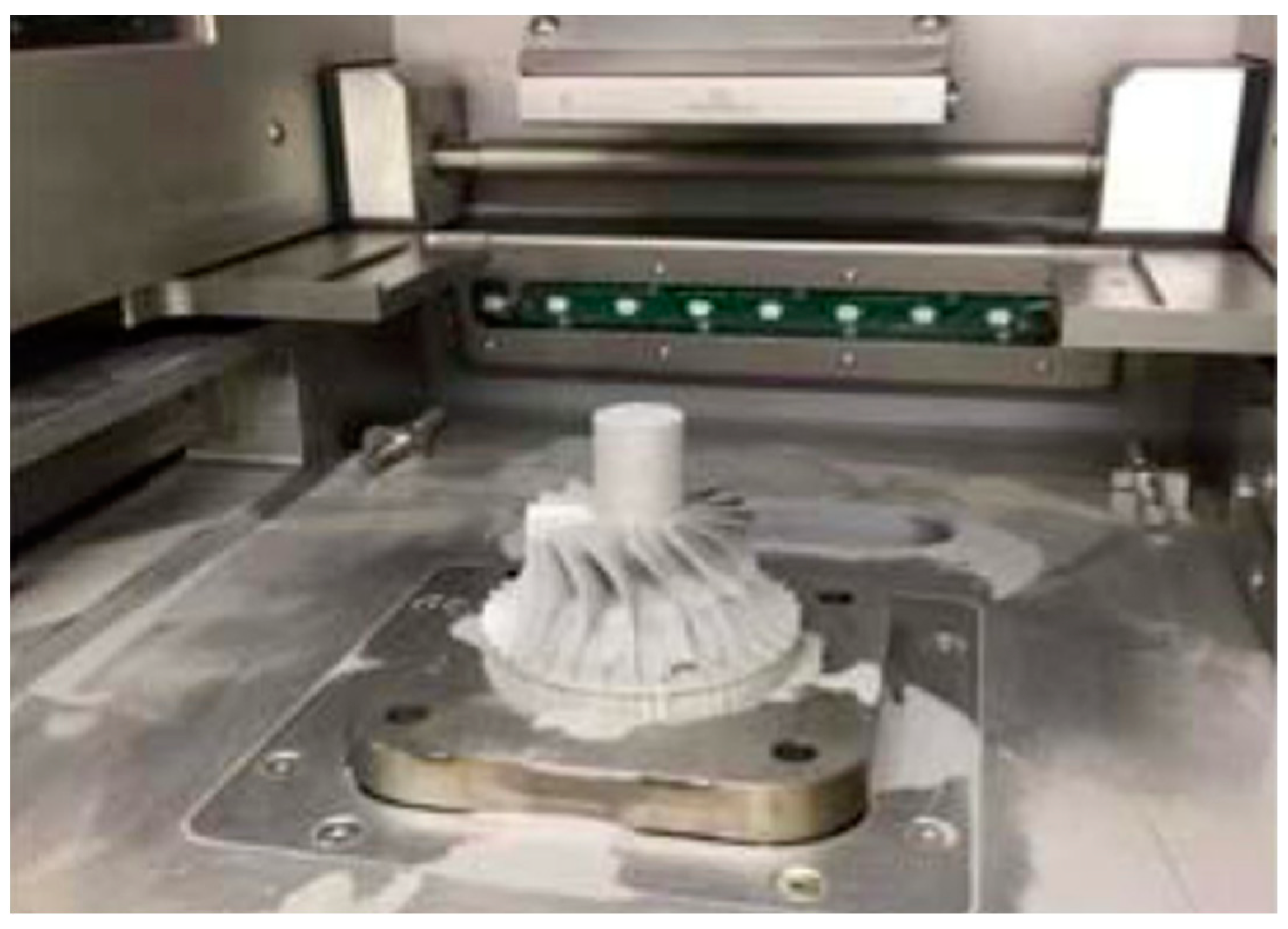
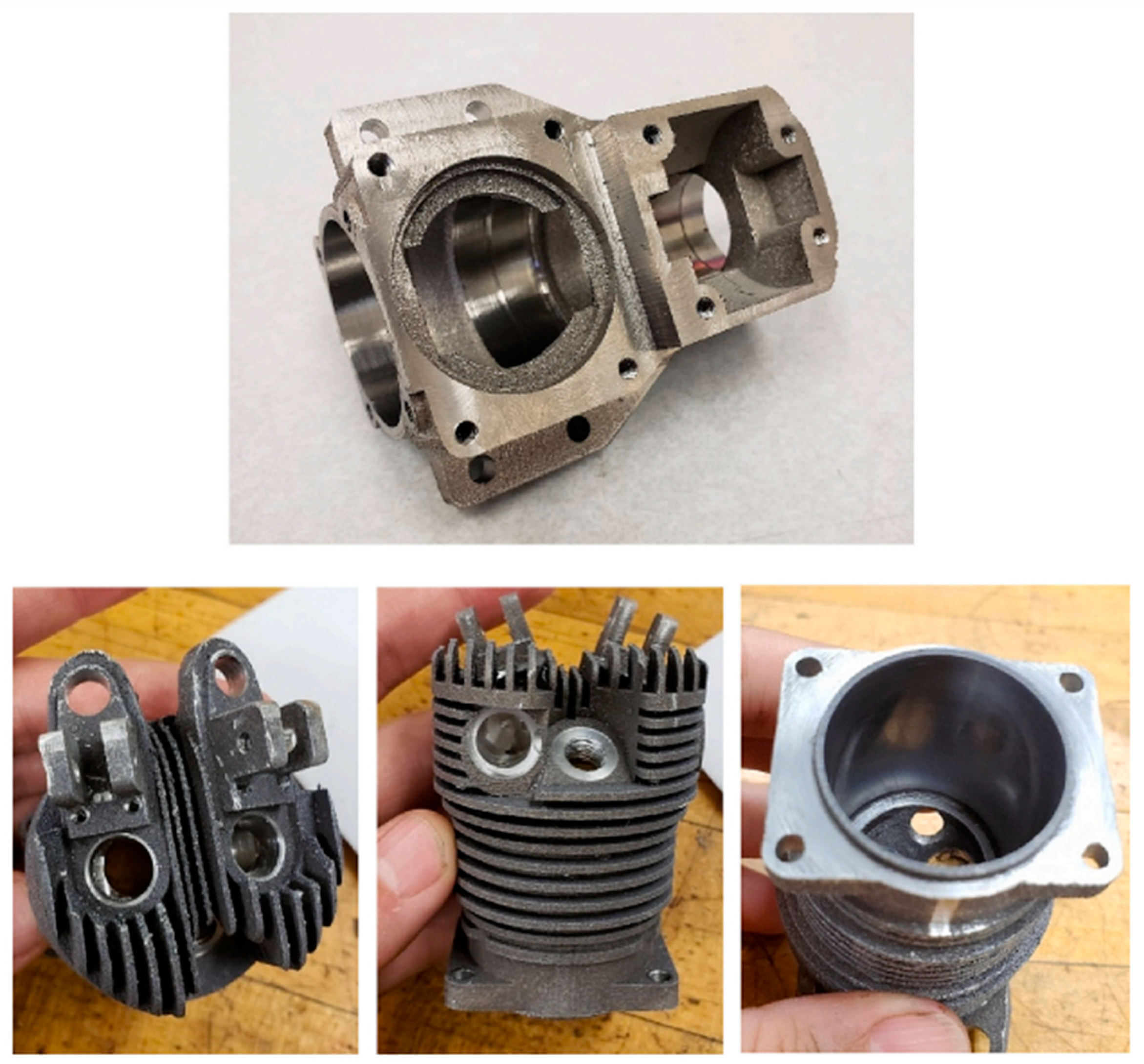
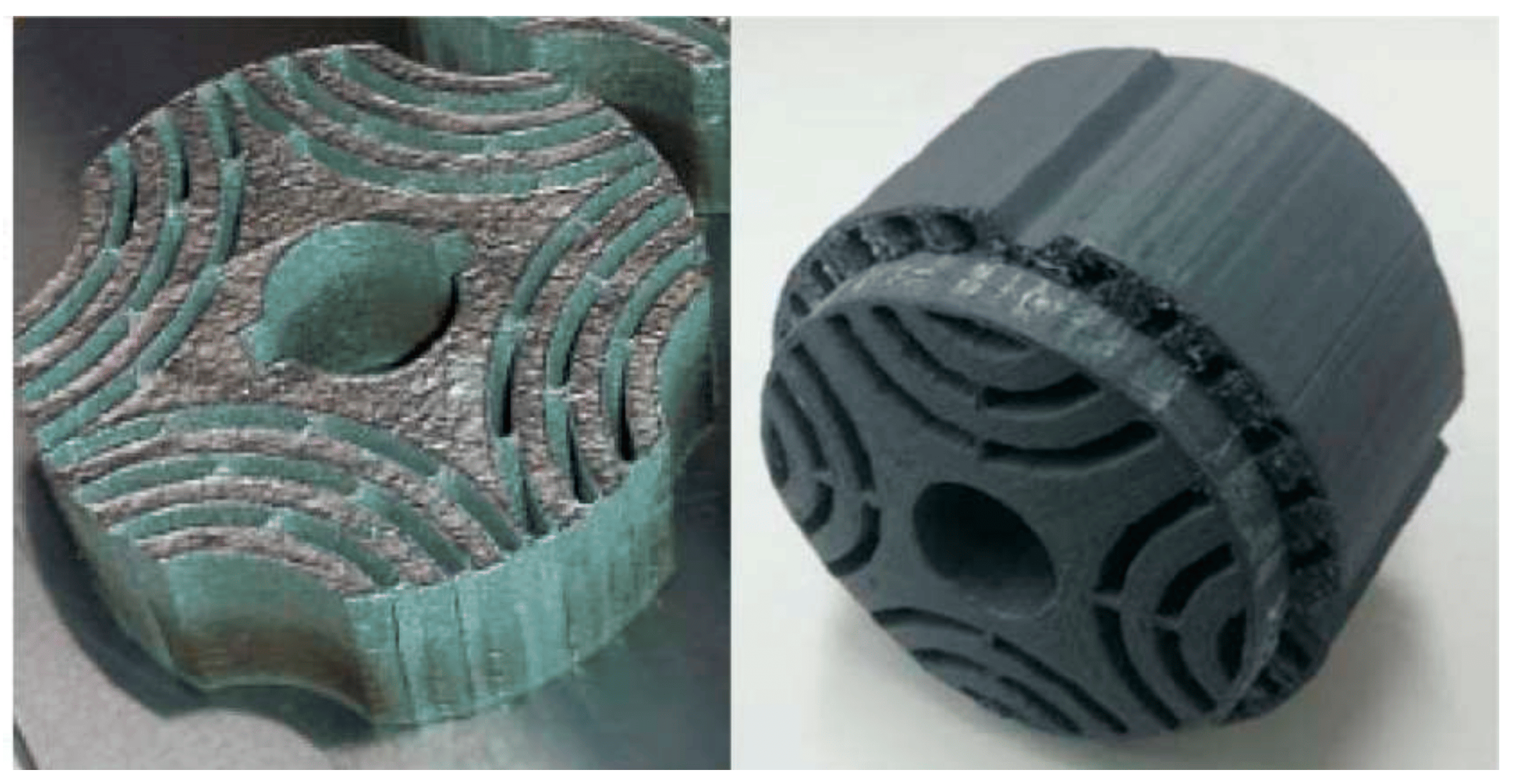
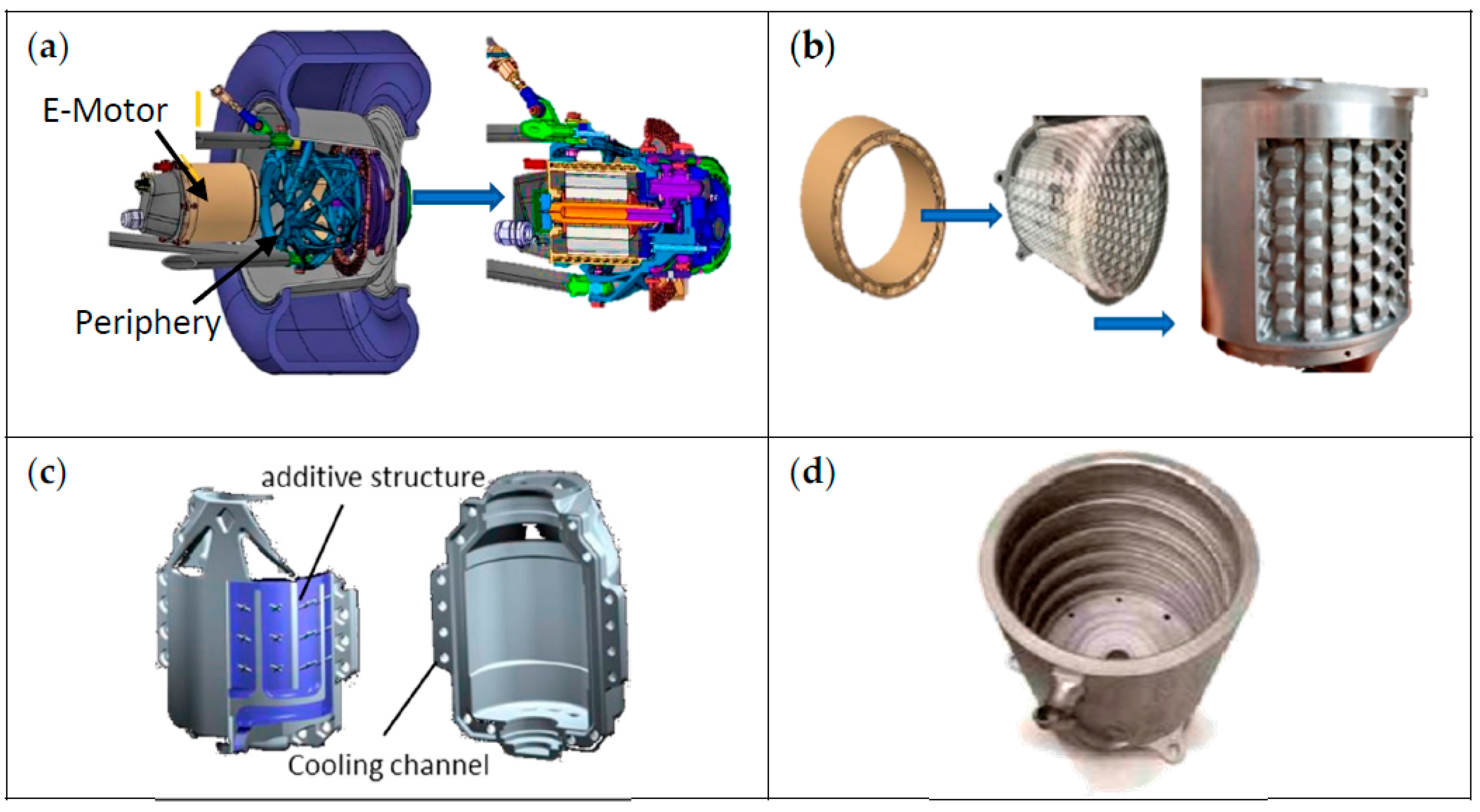
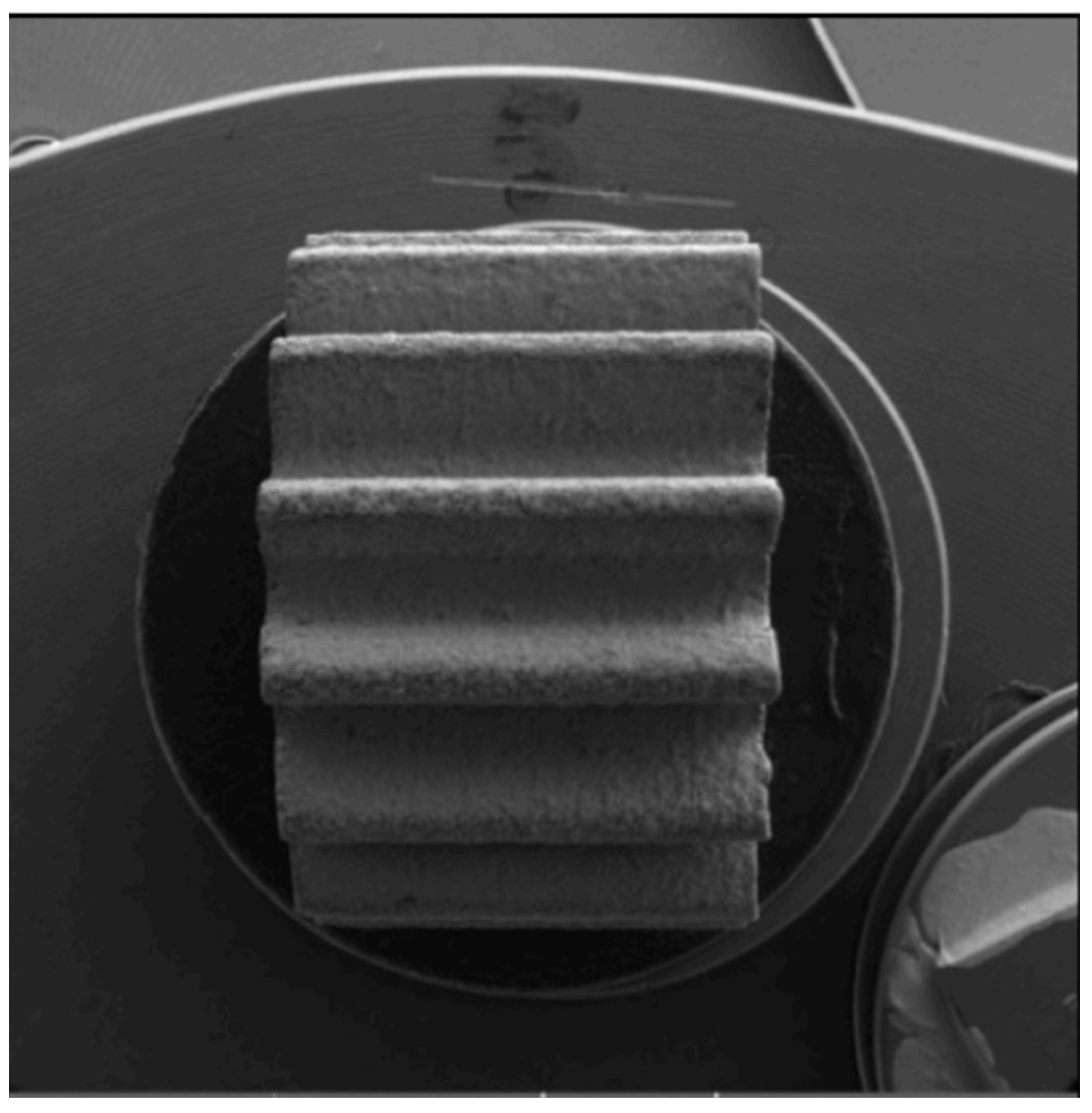
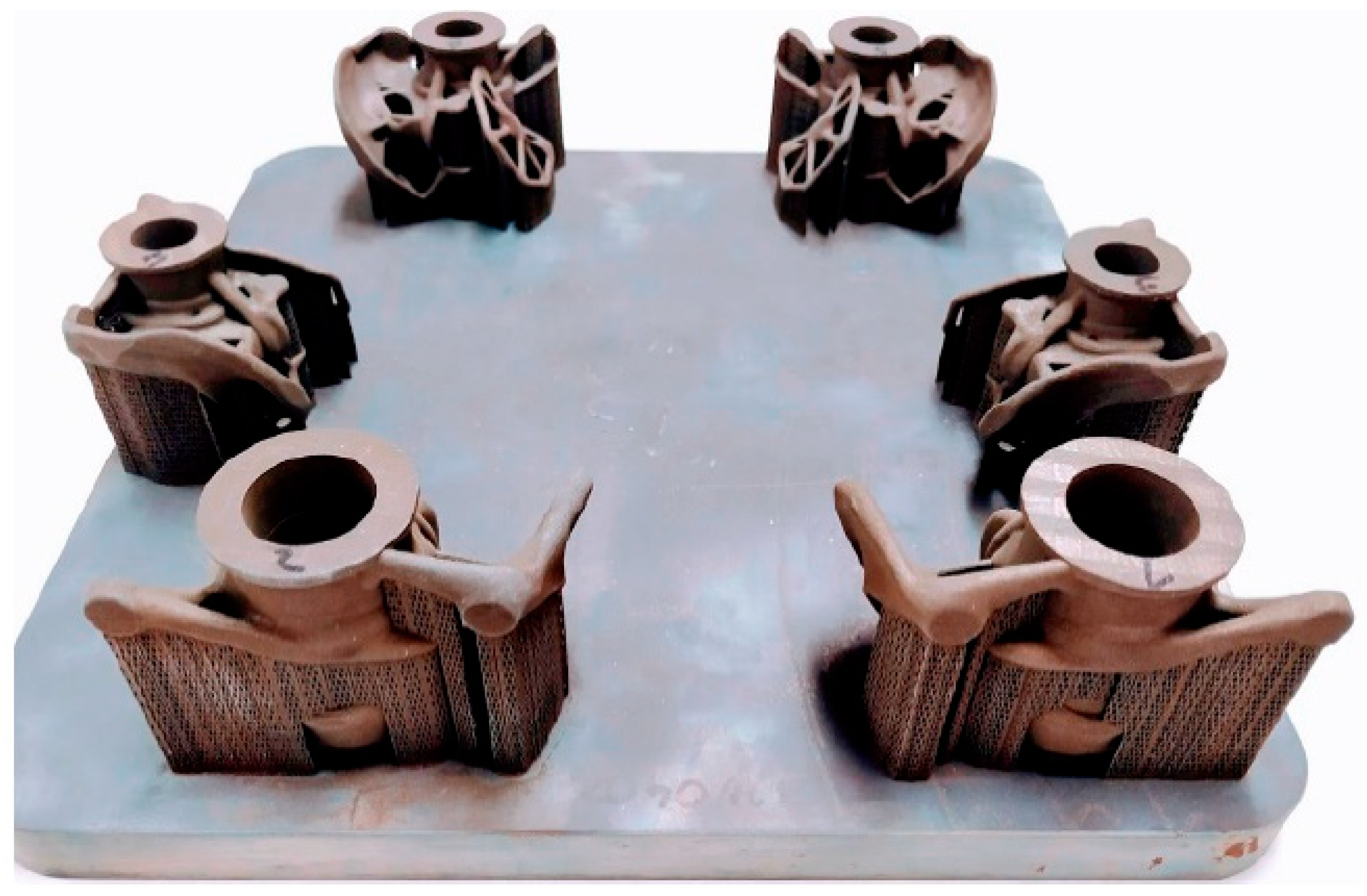
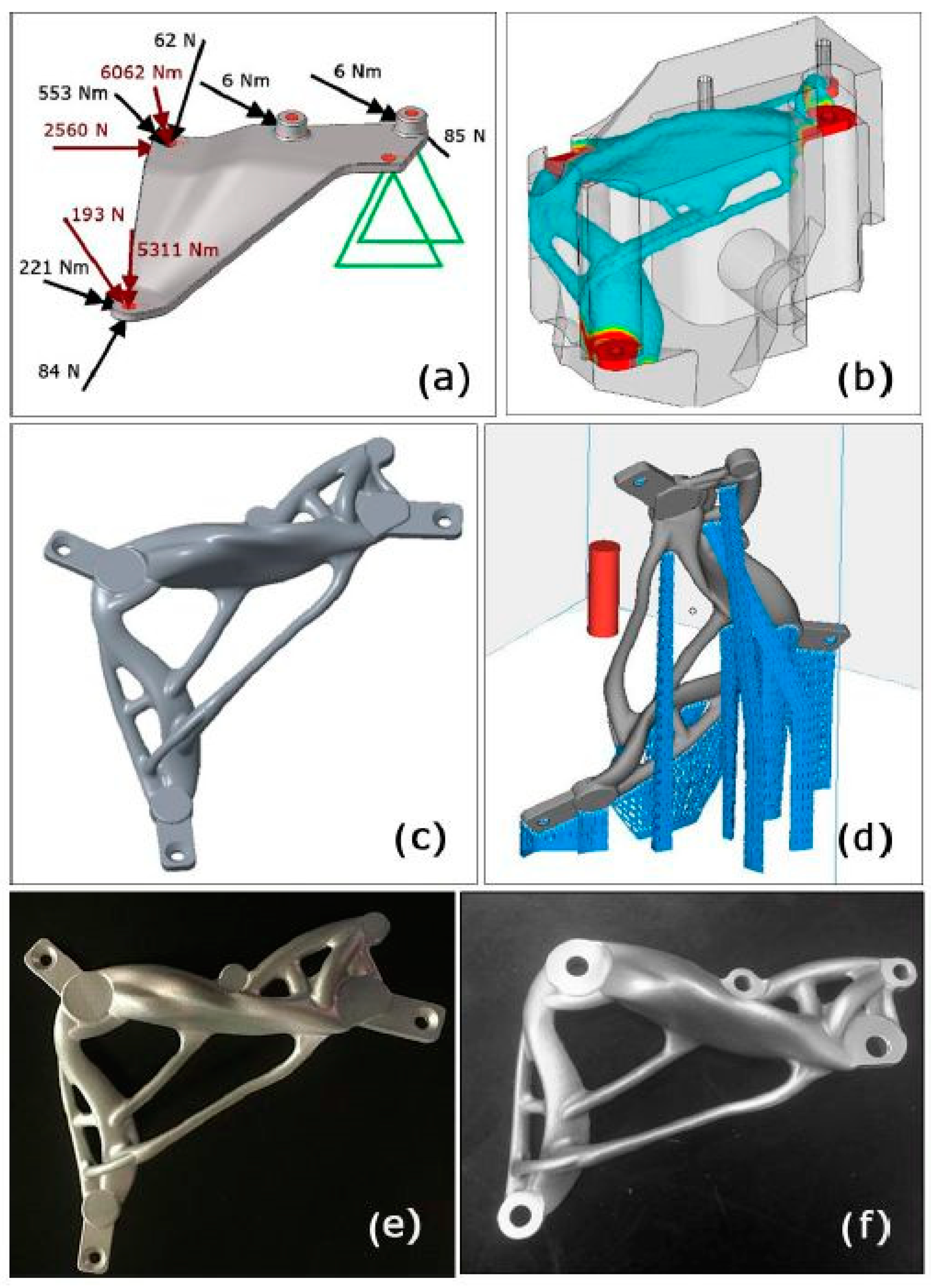
| Metal Additive Manufacturing Technique | Advantages | Disadvantages | Mainly Used Materials | Application |
|---|---|---|---|---|
| Powder Bed Fusion (PBF) | fabricating complex structures, lattice structures, high strength combined with lower weight large components, no support structures required, saving and re-use material, reduction of material waste and fuel consumption | part size limitation, production time, cost of machines and materials, number of available materials, need for post-processing (porosity, surface roughness, cracks and residual stresses) | aluminum alloys, magnesium alloys, titanium alloys, steels, Ni-based superalloys, nitinol based alloys, Zn-based, pure copper or copper alloys | manufacturing complex parts for aerospace, automobile, aeronautic, biomedical implants, industrial parts, |
| Sheet Lamination | process high speed, low cost, ease of material handling, multi-material process | strength and integrity largely rely on the adhesives used, material preparation before process | aluminum sheets, steel sheets | large surface components (aircraft wings) |
| Directed Energy Deposition (DED) | freedom in the materials domain, enabling fabrication of multi-material structures, build environment’s freeform with 5-axis to free axis deposition heads, more possibilities to repair damaged parts | production time, need for post-processing (surface roughness, cracks, delaminations and residual stresses) | titanium alloys, steels, Ni-based superalloys, aluminum alloys | repair or manufacturing parts for aerospace, automobile, aeronautic, biomedical implants, industrial parts |
| + | − |
|---|---|
| better working conditions | lower dimensional accuracy |
| mass customization and personalization | lower surface quality |
| reduced time to market | more expensive part manufacturing |
| flexibility for design changes | limited part dimensions |
| possibility to produce more complex parts | high requirements for input metals |
| shorter process and assembly chains | higher failure tests |
| fewer spare parts | higher specific energy demand |
| no need for complex tooling | need for support structures |
| on-demand manufacturing | |
| higher material efficiency | |
| improved remanufacturability | |
| less waste production | |
| weight reduction |
Disclaimer/Publisher’s Note: The statements, opinions and data contained in all publications are solely those of the individual author(s) and contributor(s) and not of MDPI and/or the editor(s). MDPI and/or the editor(s) disclaim responsibility for any injury to people or property resulting from any ideas, methods, instructions or products referred to in the content. |
© 2024 by the authors. Licensee MDPI, Basel, Switzerland. This article is an open access article distributed under the terms and conditions of the Creative Commons Attribution (CC BY) license (https://creativecommons.org/licenses/by/4.0/).
Share and Cite
Sarzyński, B.; Śnieżek, L.; Grzelak, K. Metal Additive Manufacturing (MAM) Applications in Production of Vehicle Parts and Components—A Review. Metals 2024, 14, 195. https://doi.org/10.3390/met14020195
Sarzyński B, Śnieżek L, Grzelak K. Metal Additive Manufacturing (MAM) Applications in Production of Vehicle Parts and Components—A Review. Metals. 2024; 14(2):195. https://doi.org/10.3390/met14020195
Chicago/Turabian StyleSarzyński, Bartłomiej, Lucjan Śnieżek, and Krzysztof Grzelak. 2024. "Metal Additive Manufacturing (MAM) Applications in Production of Vehicle Parts and Components—A Review" Metals 14, no. 2: 195. https://doi.org/10.3390/met14020195






